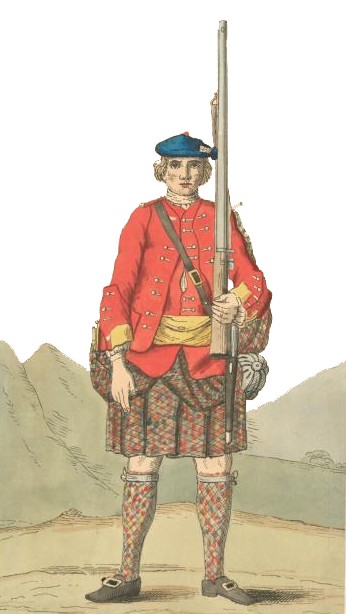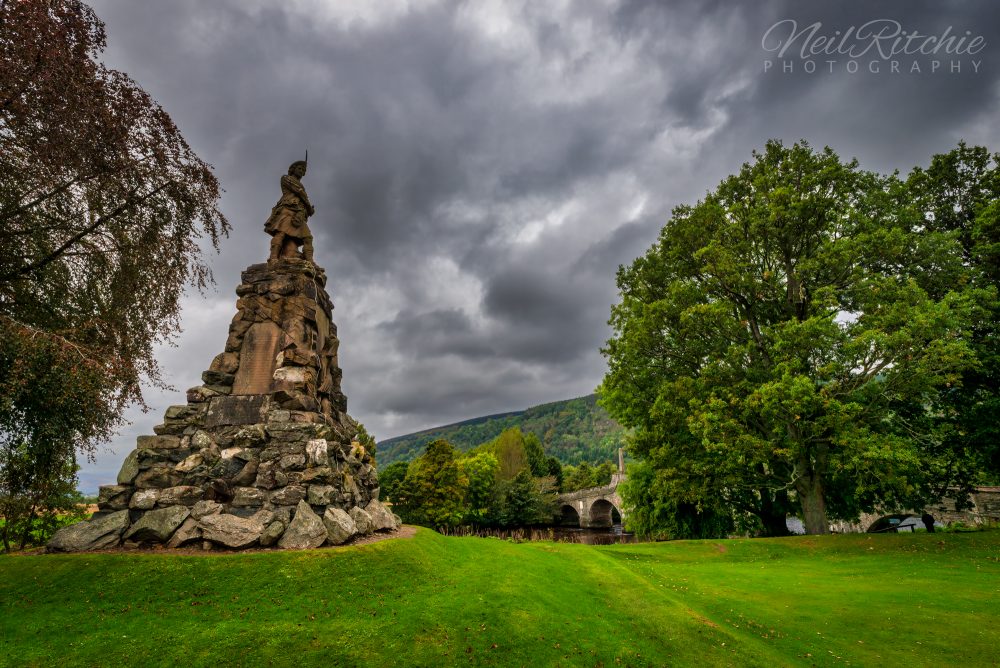
In May 1740, the 43rd Highland Regiment of Foot (Black Watch) mustered for the first time on the banks of the River Tay at Aberfeldy.
The regiment had been established by Royal Warrant on 25 October 1739 by bringing together six Independent Highland Companies to form a regular highland line regiment that would serve in the British Army.1 The colonelcy of the regiment was given to Major-General John Lindsay, Earl of Crawford with Sir Robert Munro of Foulis appointed as Lieutenant-Colonel. Four additional companies were raised and added, increasing the regiment’s strength to 1,000 men by the time they gathered at General Wade’s Taybridge outside Aberfeldy in May 1740.
The Independent Highland Companies had been re-established in 1725 by Major-General George Wade, commander-in-chief in Scotland (1724-1740). Raised from the well-affected clans, their role was to police the highlands and enforce the disarming acts that had been brought in following the Jacobite Rising of 1715. They also acted as guides and interpreters for the regular troops and suppressed blackmail (paying protection money to buy off cattle thieves) from where they got their name Am Freiceadan Dubh, the Black Watch.
Upon their formation, General Wade ordered the company commanders to ensure that all of their men’s plaids were the same or very similar colour for uniformity. This led to the companies becoming the first specific Scottish subgroups to be identified by their tartan, over 50 years before the invention of clan tartans by lowland weavers. The individual companies continued to wear tartan picked by their commanders until around 1748 when the regiment was issued with the dark government tartan. The name “Black Watch” is often incorrectly stated to derive from the dark government-issue tartan however the name predates the issuing of the dark tartan.2
The rank and file were armed with a Long Land Pattern musket, known as the Brown Bess, a bayonet and a basket-hilted broadsword which were supplied by the government. They were also permitted to carry at their own expense a dirk, pistols and a targe as was the highland fashion. The officers carried spontoons or fusils and the sergeants carried Lochaber axes. Upon their embodiment as a regiment, the companies were issued with a scarlet jacket, blue bonnet and buckled shoes.

After assembling at Aberfeldy, the regiment stayed there for more than a year, undergoing regular drill and exercise under Lieutenant-Colonel Munro. The next two years were spent in the highlands where they manned the forts and barracks, as well as patrolling General Wade’s military roads. In 1743, the regiment was ordered to London for review before being deployed to the war on the continent. While in London a rumour began to spread that the regiment would be sent to the West Indies, and more than 100 men mutinied and started heading back home. They were quickly rounded up and three of the ringleaders were executed while the rest of the mutineers were sent away for garrison duty in the West Indies.
On 30 April 1745, the regiment received its baptism of fire at the Battle of Fontenoy in Belgium where the Duke of Cumberland’s British-Allied army was defeated by the French under Marshal Saxe. They won distinction in attacking heavily fortified French positions before covering the retreat of Cumberland’s army. Cumberland was impressed by their conduct and recommended that a second regular highland regiment be established, which became the Earl of Loudoun’s 64th Highland Regiment of Foot.
In 1749 the Black Watch regiment was renumbered as the 42nd Regiment of Foot and retained this number in line until the Childers Reforms of 1881 when numbering was replaced by territorialisation.
To commemorate the first muster of the Black Watch regiment at Aberfeldy, Gavin Campbell, Marquis of Breadalbane unveiled the Black Watch Memorial overlooking Wade’s Bridge in May 1887. On top of the monument is Private Farquhar Shaw, one of three soldiers who were shot for their part in the Black Watch mutiny of 1743.
In a meadow by the Tay
Address to the 42nd Royal Highlanders by Lord Archibald Campbell of Sonachen, 1881
Gleaming river sheathed in spray
On one golden morn in May
Rose the clansmen in array
Dark their tartan as the stream
Shrill the pipes as eagles’ scream
Stern their faces as Shehallion
Leaders of the Great Battalion
Sons of those who charged at Flodden
Mindful of the drear Culloden
Keep our land by foe untrodden
Gallant Forty-second
Notes:
- Royal Warrant addressed to John Lindsay, Earl of Crawford dated 25 October 1739; The London Gazette, 1 December 1739, no. 7862. ↩︎
- In a letter dated 20 December 1735, Major Lewis Grant writing to Robert Grant of Tammore, mentioned ‘Our Northern troops alias Blak Watch’, and in a letter dated 7 April 1739, Lord Lovat used the name Black Watch to refer to the Independent Highland Companies; The Clothing Book of 1742 and a contemporary image of the Black Watch on campaign in Germany in 1743 show soldiers of the regiment in brighter tartan than the later government-issued dark green and blue tartan. ↩︎
Cite this article: Ritchie, N. (3 May 2024). The first muster of the Black Watch at Aberfeldy. https://www.scottishhistory.org/blog/first-muster-black-watch-aberfeldy/
